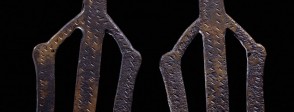Show the picture of the girdle-hanger and challenge students to work out what the mystery object is. Give them some clues: it is made of metal and would have looked like gold when new; show them the details in For the classroom; it was found in a grave; it hung on something; the terminals are meant to look like keys; it belonged to a woman. Record all their guesses as they discuss in groups.
This girdle-hanger was a symbol of authority for a woman who controlled her home. Introduce the idea that the key is a symbol. What kinds of thing do they think a key might symbolise. What other symbols of authority carried or worn by people today can they think of? Make a list of modern day symbols of authority. Research some symbols of authority in different cultures. How are they similar or different?
Use the search function on the Portable Antiquities Scheme website to find a selection of girdle-hangers found around England - see For the classroom. Ask students to design a miniature girdle-hanger as a key and the lock that it would open. How would they make sure that only that one key could open the lock? Do they need to make any changes once they have tried out their key to make it work? Does this practical work give them a sense of whether the girdle-hangers could have been keys, or were just meant to look like them?
The next four teaching ideas use the objects in A bigger picture. There are also useful resources related to Anglo-Saxon burials in Object file: Figure of an Anglo-Saxon man.
Show students the other objects that were found in the grave of the woman at Searby. Was she rich or poor? Ask them to explain their answer. Can they draw what she might have looked like? Some clues are that her imitation key would have been hanging from her belt; the brooch might have held her cloak and the pin could have been worn to keep her hair up.
The girdle-hanger was found in a grave. Most of what we know about early Anglo-Saxons comes from what they put in their graves. All the objects in A bigger picture were found in graves. Why do the students think Anglo-Saxons wanted to be buried with these objects? What do they say about their owners? What do they say about the relatives of the dead person?
What do the objects people were buried with tell us about what jobs they did when they were alive? Did men and women do different jobs? What were they? Do the objects they are buried with tell us how men and women dressed in the Anglo-Saxon period? Did they wear similar or different clothes and jewellery? Use the resources from the Ashmolean Museum in For the classroom to explore the burials of men, women and children.
Make a full set of grave goods for an Anglo-Saxon man or woman to put on display. Use beads to make necklaces and drop-spindles, metallic card or foil with stick on plastic jewels to make brooches, weapons and girdle-hangers. Ask students to make typical Anglo-Saxon shapes and decoration with the materials.
Use the BBC Anglo-Saxon excavation game and the Portable Antiquities Scheme Anglo-Saxon Village game in For the classroom. Explore how archaeologists work. What sources of evidence are there for the Anglo-Saxons? How do we know what people wore? How do archaeologists find Anglo-Saxon objects? What do they do with them afterwards?


